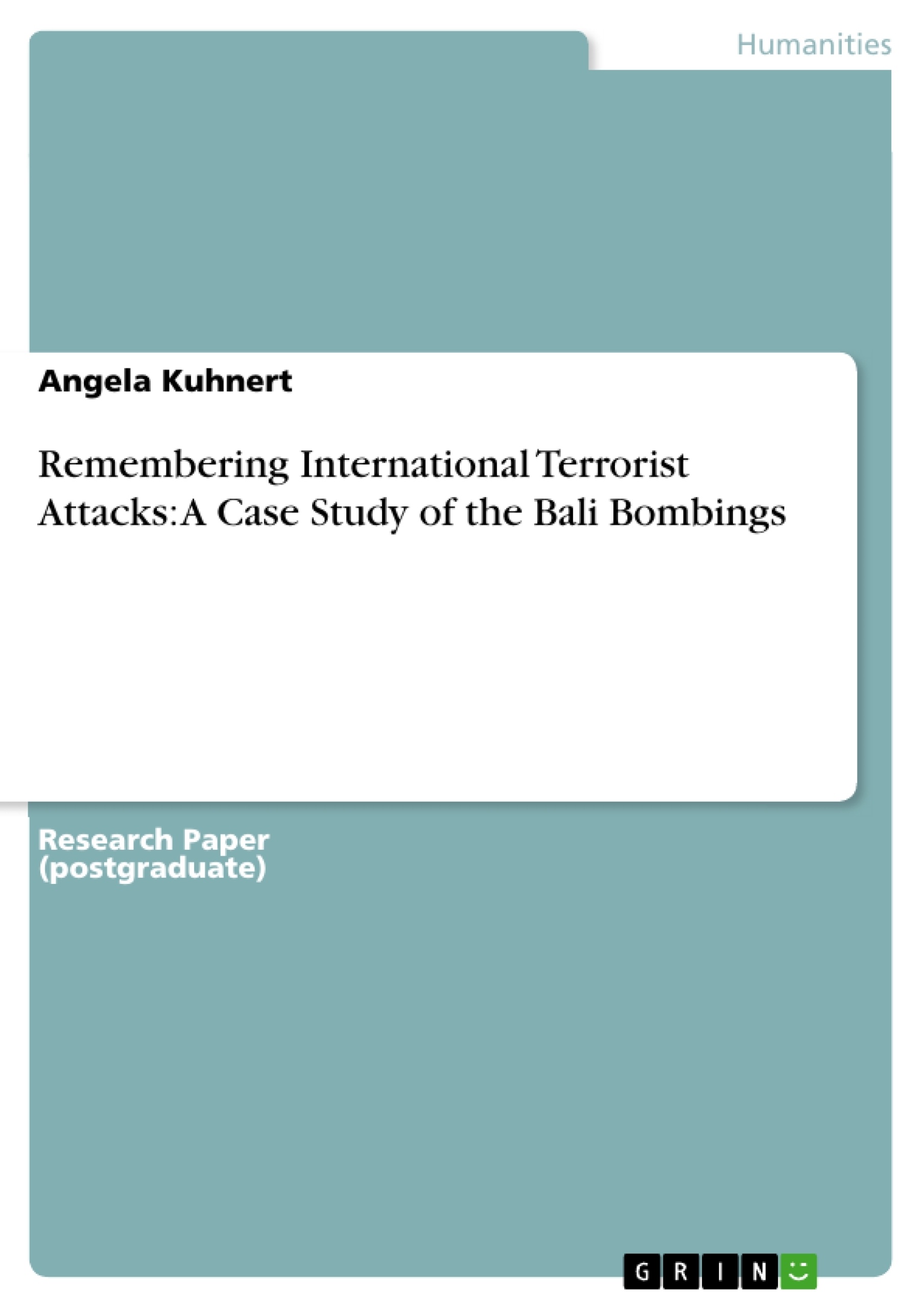Worldwide numerous terrorist attacks have shattered societies. In recent time, especially those generating a sense of the West versus the Muslim world, gained large public attention such as the attacks of the World Trade Center in New York City in 2001 and the bombings of Madrid in 2004 and London in 2005. Attacks, such as these, have not only happened on ‘Western ground’, but also Indonesia has been a victim of several terrorist attacks mainly targeting sites predominantly visited by Westerners, such as the hotel bombings in Jakarta in 2009 and the Bali Bombings in 2002 and 2005. The initiator of these terrorist attacks was the Islamic group Jemaah Islamiah with its spiritual leader Abu Bakar Bashir (West, 2008). This organization strives for an introduction of Shariah law in Muslim nations and perceives the Islamic faith to be oppressed by increasing influence of Western values in the Islamic World (West, 2008). Jemaah Islamiah, thus, justifies its attacks as defending the religion of Islam and its values from the perceived thread of the Western influence. Large attacks such as these in Indonesia lead to a large media attention, especially the random and high number of foreign victims lead to worldwide attention (Blakesley, 2007; Crenshaw, 2000; Turk, 2004). Therefore following definition of terrorism by Gibbs (in Turk, 2004, p. 284) will be used in this paper:
Terrorism is threatening, perhaps illegal, clandestine (avoiding conventional warfare) violence against human or nonhuman objects that is intended to change or maintain some belief, law, institution, or other social "norm" by inculcating fear in persons other than the immediate targets.
Gibbs, therefore, considers an attempt for social control as a possible base for explanatory theory (Turk, 2004). Johnson (1994 in Crenshaw, 2000, p. 415) states how the loss of order and control leads to an exaggeration of the likelihood of such an attack. Destabilizing society by shattering its moral values is used to put forward a political message.
“’Memory is the meaning we attach to experience, not simply recall of events and emotions of that experience' (Stern, 2004 in Barbara, 2009, p. 83); and is thus necessary to make sense of the present; it provides a time and space reference and is therefore also crucial in order to build the future” (Barbera, 2009, p. 76). Halbwachs distinguishes between autobiographical memory which is the memory of our firsthand experience, historical memory which is gained thr
Inhaltsverzeichnis (Table of Contents)
- 1. Introduction.
- 2. Methodology
- 3. The Case: Bali Bombings of 2002 and 2005.
- 4. Why do we remember events?
- 4.1. Terroristic Attacks Lack Meaning.
- 4.2. A Sudden Loss of Security
- 4.3. Media Attention.
- 4.4. Embodiment of Memory
Zielsetzung und Themenschwerpunkte (Objectives and Key Themes)
This paper explores the reasons behind remembering terrorist attacks, using the Bali bombings of 2002 and 2005 as a case study. The primary goal is to understand the significance of memory and how it shapes collective understanding and responses to traumatic events. The paper examines the role of individual and collective memory in shaping the perception and experience of terrorist attacks, specifically focusing on the impact of a sudden loss of security, the influence of media attention, and the ways in which traumatic memories are embodied in various forms of commemoration and remembrance.
- The importance of collective memory in shaping our understanding of events and the role of individual memory in contributing to the collective.
- The impact of terrorist attacks on the sense of security and the psychological consequences of experiencing such events.
- The influence of media coverage and representation in shaping public understanding and memory of terrorist attacks.
- The ways in which memory is embodied in various forms of commemoration, including ceremonies, monuments, and narratives.
Zusammenfassung der Kapitel (Chapter Summaries)
- Chapter 1: Introduction: This chapter sets the stage for the paper by introducing the significance of terrorist attacks in shaping societies, particularly those that highlight the perception of a "West versus Muslim world." It highlights the impact of attacks in Indonesia, specifically the Bali bombings of 2002 and 2005, as examples of events that gained widespread international attention due to the high number of foreign victims. This chapter further introduces the key concept of terrorism as an act of social control and its potential for destabilizing societies by shattering moral values.
- Chapter 2: Methodology: This chapter outlines the research methodology employed in the paper, which includes a combination of literature review and a case study approach. The paper specifically focuses on the Bali bombings, recognizing the limitations of generalizability due to the unique nature of the event. The chapter emphasizes the use of a variety of sources, including journal articles, newspaper articles, interviews, books, and films, to provide a comprehensive understanding of how the Bali bombings are remembered and commemorated.
- Chapter 3: The Case: Bali Bombings of 2002 and 2005: This chapter presents a detailed description of the Bali bombings, providing information about the events, casualties, and the perpetrators involved. It highlights the targeting of Western tourists and the specific impact on both foreigners and Indonesians. The chapter also explores the motives behind the attacks, highlighting the role of the Islamic group Jemaah Islamiah and their perceived need to defend Islam against Western influence.
Schlüsselwörter (Keywords)
The core concepts explored in this paper include collective memory, individual memory, terrorist attacks, trauma, security, media representation, commemoration, and the Bali bombings. The paper investigates the interplay between these themes and their impact on how societies remember and respond to violent events.
- Arbeit zitieren
- Angela Kuhnert (Autor:in), 2014, Remembering International Terrorist Attacks: A Case Study of the Bali Bombings, München, GRIN Verlag, https://www.grin.com/document/280167



